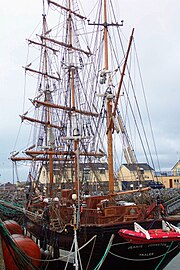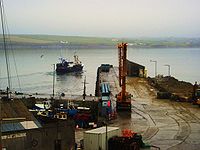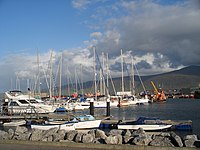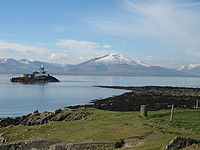Difference between revisions of "Fenit"
(Created page with "{{Infobox town |name=Fenit |irish=An Fhianait |county=Kerry |picture=Fenit Harbour & Island.JPG |picture caption=Fenit village, harbour and island. |os grid ref=Q725154 |latit...") |
(No difference)
|
Latest revision as of 20:53, 6 September 2024
| Fenit Irish: An Fhianait | |
| County Kerry | |
|---|---|
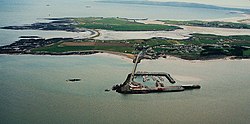 Fenit village, harbour and island. | |
| Location | |
| Grid reference: | Q725154 |
| Location: | 52°16’37"N, 9°51’29"W |
| Data | |
| Population: | 619 (2022) |
| Local Government | |
Fenit is a small village in County Kerry, found on north side of Tralee Bay about six miles west of Tralee, just south of the Shannon Estuary.
Tralee Bay is enclosed from the Atlantic by the Maharee spit which extends northwards from the Dingle Peninsula. Fenit harbour on the bay is a mixed function, as a sea port, where fishing, freight import and export, and a 136 berth marina are the main forms of business.
The 2022 census recorded a population of 619.
Contents
History
Tradition has it that St Brendan the Navigator was born north-west of the village on Fenit Island in close proximity to what is now Fenit harbour around 484,[1] and he is honoured by a large bronze monument in the harbour area. It has been suggested that Brendan arrived in the Americas prior to Christopher Columbus but this has not been proven. Though Tim Severin demonstrated it is possible that a leather-clad boat such as the one described in the Navigatio could potentially have reached North America.[2][3]
In 1588, as the Spanish Armada dispersed, the sloop Nuestra Señora del Socorro, of 75 tons, anchored at Fenit, in Tralee Bay and surrendered. The 24 men on board were taken into custody, marched to Tralee castle, and, after interrogation, executed.
In the mid-19th century, the sailing ship Jeanie Johnston traded out of Tralee, transporting emigrants to the US and Canada and in 2000 a replica was built in Fenit Harbour.
The village and environs were the scene of the ill-fated attempt of Roger Casement and associates to land arms at Banna Strand to aid the Easter Rising. Casement was landed from a German submarine, just north of the harbour in the early hours of 21 April 1916, but the ship, Aud Norge, never landed at Fenit and was scuttled in Cork harbour by its German captain lest the British forces take possession of the arms cache. History repeated itself when in 1984, the Marita Ann a Fenit-registered boat, attempted a similar operation on behalf of the Provisional Irish Republican Army. They were discovered by the authorities and arrested off the coast.
On 2 August 1922, during the Irish Civil War, Fenit was the scene of a major seaborne landing, from the ship Lady Wicklow, by 450 Free State troops, as part of a civil war offensive to re-take Kerry and the Republican-held province of Munster. The republican forces had intended to blow up the pier if an attack was launched but the charges were rendered inoperable by unknown persons in an attempt to minimise damage to the port.[4]
Harbour
The harbour at Fenit is the most westerly commercial port of Ireland and Europe. The port is owned by the Irish state and was operated under the 1946 Harbours Act by the Tralee and Fenit Pier and Harbour Commissioners until October 2011, when it became the responsibility of the Kerry County Council. Fenit is the only commercial port between Foynes on the River Shannon and Cork. It is located between Kerry Head to the north and Brandon Head to the south. The deepwater port is a major asset to County Kerry and caters for vessels up to 17,000 Dwt.
The Tralee Harbour Board was established in 1840. Commercial shipping started to use Blennerville, at the head of Tralee Bay, as the access point for the town of Tralee. Prior to this cargo for Tralee was transported through Barrow Harbour, a natural sea inlet, just north of Fenit. Barrow Harbour was, historically, the port used to service Ardfert, now a village but, in the monastic era, it was a major ecclesiastical centre with students and monks from many parts of Europe. In 1880, Fenit harbour was built and the Harbour Board took on the name "Tralee and Fenit Pier and Harbour Board".
Fenit has traditionally served as the merchants' port for Tralee. Coal, grain timber, etc., were landed during the 20th century with oil and cranes becoming the main cargo until the fuel distribution base was dismantled in the late 1990s. The main deep sea pier is 574 feet long with extensive storage facilities available. Regularly accommodating 15,000 tonne ships, the port is a very picturesque mixed use port with a marina, fishing and commercial ships. There are about 15 shipments a year; almost totally due to the export of container cranes manufactured by Liebherr's Irish subsidiary, based in Killarney, which are shipped all over the world.
The port was a major port for landing fish in the 1970s. The local fishing industry has all but ceased due to EU quota limits and competition from larger fleets from Spain and France. Until 2006, French companies still used the port to land fish that were then transported directly to the European mainland. The oil industry has, in the past, used Fenit as a base for their supply boats on several occasions when exploring off the west and south-west coast of Ireland.
Marina
Fenit Marina, built in 1997, largely with the aid of EU funding, is a 130-berth marina located at Fenit harbour[5] and connected to the land by an causeway 900 yards long and viaduct.
Lighthouse
- Main article: Little Samphire Lighthouse
In 1851 a lighthouse was built on the Little Samphire Island, located a few hundred yards west of Fenit pier. A large bronze sculpture of Saint Brendan was erected in 2004 on Great Samphire Island, the rock around which the harbour was built.
This island has been utilised as part of the port development and its name 'Great Samphire Island' appears to refer to the height when compared to its much flatter twin, Little Samphire Island.
Railway
A railway once serviced Fenit and freight trains travelled over the viaduct to transfer freight between ship and train. In 1887 the railway line was built, but by the 1970s the service ceased.
Fenit railway station opened on 5 July 1887, closed for passenger traffic on 31 December 1934 though it was still used for ad hoc day-tripper excursions from Tralee and closed for goods traffic until 2 June 1978.[6]
About the village
Fenit Castle, a tower house, was built in the 16th century to protect the entrance to Barrow Harbour. This was built by the FitzMaurice clan and still commands a dominant position over the surrounding landscape. Other notable buildings include the customs house, now derelict, the redbrick RIC barracks buildings, now private houses, the stone built lifeboat house that is now disused. The large estate of Fenit House and its grounds dominate the village on the shore-side of the main road into the village. Formerly the Fuller's and Hurley estate, it was built in 1910.
Sport
Tralee Golf Club had their original course situated on Fenit island at the end of the 19th century, and it now exists across the straits of Barrow Harbour, having also been located at two venues in Tralee; Mounthawk and Lis Beg, Oakpark in the interim.
Recreational angling is a common activity in Fenit, where many visitors fish from the viaduct. Tralee Bay Sea Angling Club, the largest angling club in Ireland, have their clubhouse on the marina breakwater in the harbour. Tralee Bay Sailing Club have a slipway and clubhouse building on a prominent point overlooking the harbour and bay.
- Football: Fenit Samphires', established in 1994
- Gaelic football: Churchill GAA
Outside links
References
- ↑ Allen, John Logan (1997). North American Exploration: A New World Disclosed. Volume: 1. University of Nebraska Press. p. 18.
- ↑ Severin, Tim. The Brendan Voyage: A Leather Boat Tracks the Discovery of America by the Irish Sailor Saints. McGraw-Hill Book Company. 1978. ISBN 0-07-056335-7.
- ↑ (1964, Robert Reily) Irish Saints page:37, Wing Books, New Jersey, ISBN 0-517-36833-1
- ↑ Harrington, Niall C. (January 1992). Kerry Landing, August 1992: An Episode of the Civil War. Anvil Books. ISBN 0-947962-70-0.
- ↑ "Tralee and Fenit Marina". Tralee and Fenit Harbour Commissioners. 11 February 2007. http://www.fenitharbour.com/marina.html.
- ↑ "Fenit train station". Railscot – Irish Railways. http://www.railscot.co.uk/Ireland/Irish_railways.pdf.
- An Fhianait / Fenit: Placenames Database of Ireland
